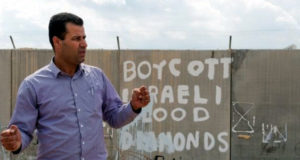By Dan Keidar and Akiva Eldar, Haaretz Correspondents, 24th May 2006
At least two settler families moved on Tuesday into apartments in a neighborhood of the West Bank settlement of Upper Modi’in that was built illegally on land belonging to the neighboring Palestinian village of Bil’in.
The move came in flagrant disregard of a Supreme Court injunction forbidding the occupation, transfer of ownership, or use of structures in the Matityahu East neigborhood.
Palestinian farmers reported on Tuesday afternoon that they witnessed from their fields two families in the neighborhood unloading their belongings from moving trucks.
“We were working on our land when we saw moving trucks enter the neighborhood,” said Mohammed Hatib, a Bil’in resident. “We approached the area and saw families enter the apartments. We asked them not to enter, because the court made their entrance illegal.”
According to the Bil’in residents, their request was ignored, after which they attempted to physically stand in the way of the settlers.
Attorney Michael Sfard, who represents Bil’in residents, called the police, who arrived after he threatened to a file motion charging the them with contempt of court unless they stopped the settlers. However, their arrival did not prevent the settlers from moving in.
Last December, Haaretz exposed the construction of Matityahu East, which was acquired from Bil’in residents through suspected fraudulent land purchases. The affidavit affirming the transfer of ownership was signed by an attorney representing the settlers, instead of by the head of Bil’in, as is customary.
The separation fence under construction runs through Bil’in, and separates the village from substantial parts of its land, including the portion on which Matityahu East was built.
According to the Palestinians and Israeli activists, the construction of the neighborhood helped determine the route of the fence. They say that the settlers appropriated the private land and it leased to building contractors run by settler leaders, which helped, along with the separation fence, create facts on the ground.
 International Solidarity Movement Nonviolence. Justice. Freedom.
International Solidarity Movement Nonviolence. Justice. Freedom.




